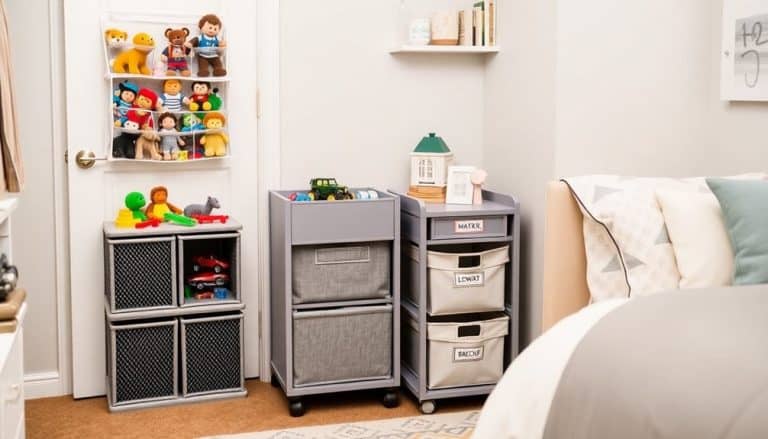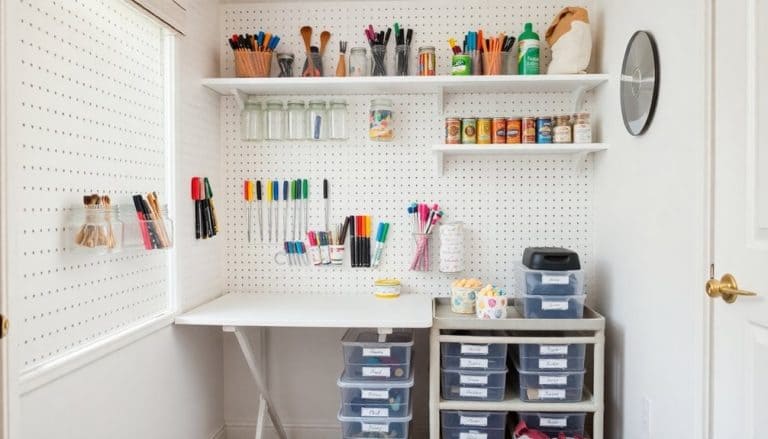This website contains affiliate links. Some products are gifted by the brand to test. As an Amazon Associate, I earn from qualifying purchases. The content on this website was created with the help of AI.
You’ll transform your workout space from chaotic to organized with these five essential steps. First, assess your equipment by taking inventory and evaluating each item’s condition. Then, sort everything into distinct categories and purge unused or damaged pieces. Next, choose appropriate storage solutions like wall mounts, racks, and bins that maximize your space. Create dedicated zones for cardio, strength training, flexibility work, and accessories to optimize workflow. Finally, implement a clear labeling system and maintain organization with regular checks and cleaning schedules. These proven strategies will help you build a workout space that keeps you motivated and efficient.
Key Takeaways
- Take inventory of all fitness equipment and assess condition, discarding damaged items and keeping only what you regularly use.
- Sort equipment into distinct zones: cardio, strength training, flexibility, and accessories, ensuring logical placement and accessibility.
- Install appropriate storage solutions like wall-mounted racks, shelving units, and weight trees based on equipment type and space.
- Label all storage containers, bins, and zones clearly to maintain organization and enable quick equipment location.
- Establish a regular maintenance routine to clean equipment, check organization systems, and adjust storage as needed.
Assess Your Equipment
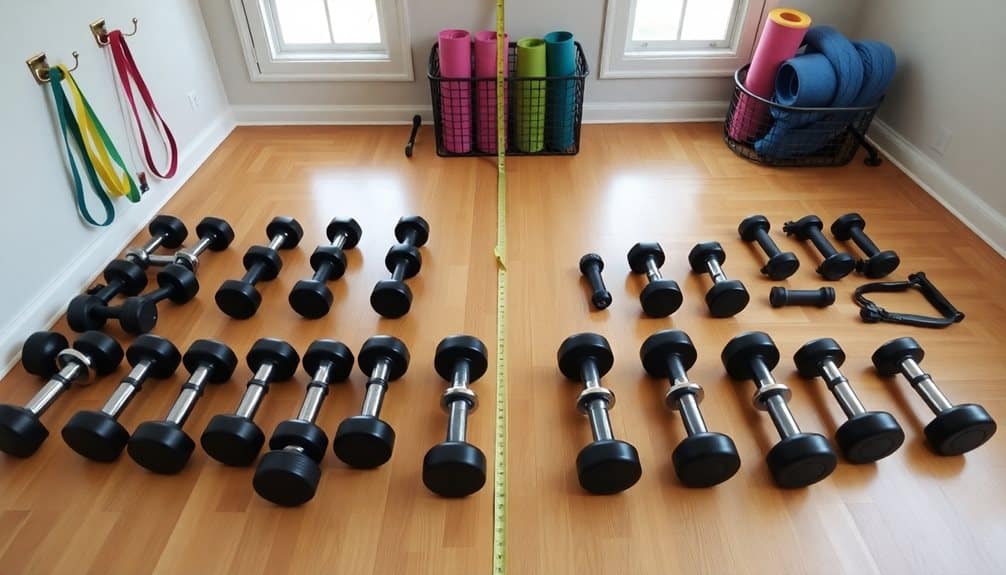
Start by taking inventory of all your workout equipment, noting both frequently and rarely used items. Create a detailed list categorizing your equipment by type: cardio machines, free weights, resistance bands, yoga accessories, and miscellaneous gear. Don’t forget to include smaller items like jump ropes, foam rollers, and exercise mats.
Evaluate each piece’s condition and functionality. Check for wear and tear, loose parts, or damage that might affect performance or safety. Set aside any broken equipment that needs repair or replacement. You’ll also want to measure larger equipment to determine space requirements for your organizational system.
Consider your workout routine and how often you use each piece. If you haven’t used certain items in over six months, decide whether to keep, donate, or sell them. Track which equipment you use most frequently – these items should be easily accessible in your final organization plan. Identify items that can be stored together based on workout type or equipment category. This assessment will help you determine the storage solutions and space allocation you’ll need for an efficient workout area.
Sort and Purge
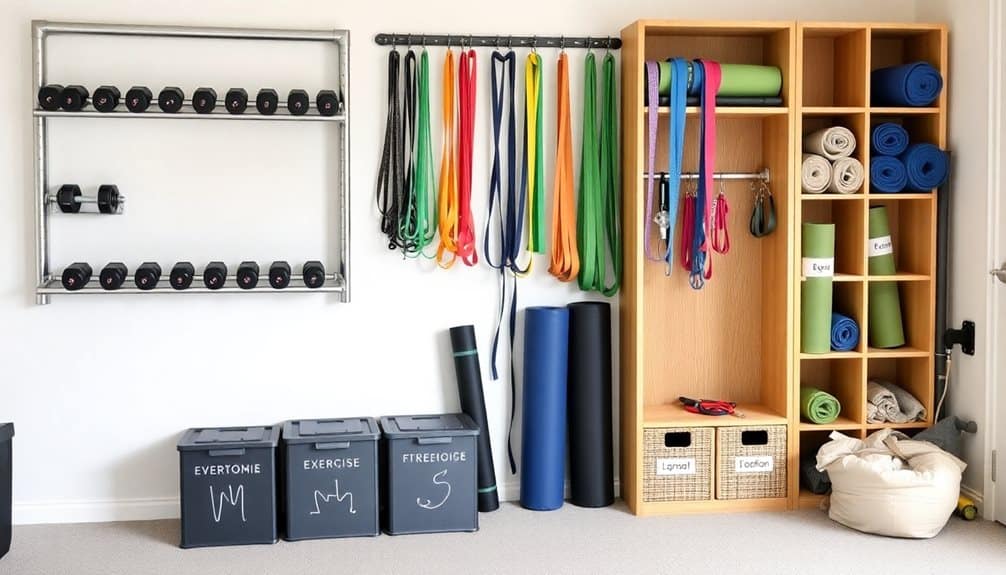
A cluttered home gym becomes manageable when you divide equipment into clear categories for assessment. Start by creating distinct zones: cardio equipment, strength training gear, accessories, and workout extras. Place each item in its designated category, making it easier to evaluate what you’ve accumulated.
Now it’s time to make tough decisions about each piece. Apply these criteria: Have you used it in the past six months? Is it still functional and safe? Does it align with your current fitness goals? If you answer “no” to any of these questions, add the item to your purge pile. Don’t keep equipment just because it was expensive or might be useful someday.
Create three separate piles: keep, donate/sell, and trash. Equipment that’s broken or unsafe belongs in the trash. Good condition items you don’t use can be sold online or donated to local gyms, schools, or charitable organizations. Your “keep” pile should contain only the equipment you regularly use and that supports your fitness routine. This process guarantees you’re left with a purposeful collection of gear that serves your workout needs.
Choose Storage Solutions
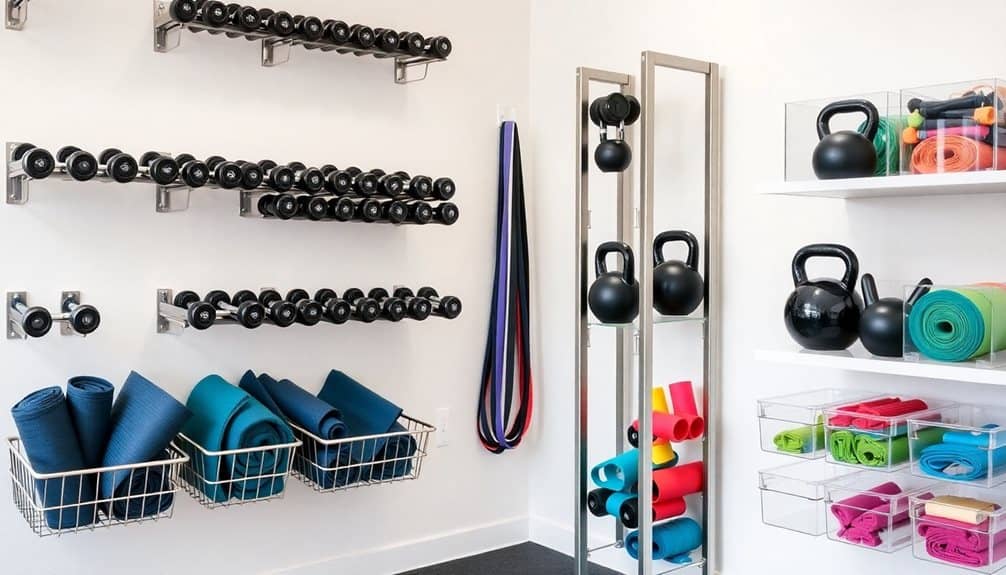
The right storage solutions transform a chaotic workout space into an efficient home gym. Start by evaluating your available space and specific equipment needs. Consider vertical storage options like wall-mounted racks for resistance bands, yoga mats, and foam rollers. Install pegboards to hang lightweight items such as jump ropes and resistance bands, maximizing wall space while keeping equipment visible and accessible.
For free weights, invest in a sturdy weight tree or tiered rack that keeps dumbbells and kettlebells organized by size. Large equipment like medicine balls and stability balls can be stored in mesh bins or on ball racks. If you’re dealing with limited floor space, look for multifunctional storage benches that double as workout surfaces.
Install heavy-duty shelving units for boxed items and smaller accessories. Use clear, labeled containers to store workout gloves, straps, and other small gear. Consider mobile storage solutions like rolling carts for equipment that needs to be moved frequently. If you have adjustable equipment or pieces that break down, dedicate a specific zone with appropriate storage to keep all components together. Remember to position frequently used items at easily accessible heights. Similar to organizing garden tools, implementing smart storage solutions can maximize your available workout space while keeping equipment protected and easily accessible.
Create Essential Zones
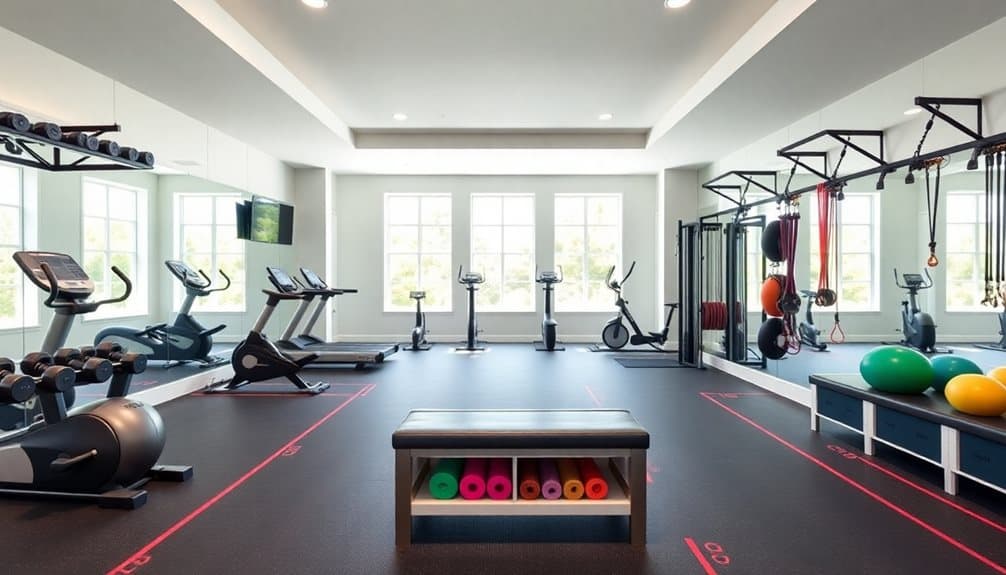
Organizing workout equipment into distinct zones maximizes efficiency and helps maintain a consistent exercise routine. Start by dividing your space into four main zones: cardio, strength training, flexibility, and accessories. Design each zone to flow naturally into the next, considering your typical workout progression.
Place your cardio equipment, like treadmills or bikes, in a zone with adequate space for movement and proper ventilation. Create a strength training zone that groups weights, resistance bands, and weight benches together, arranging them by weight or exercise type. Designate a flexibility zone for yoga mats, foam rollers, and stretching equipment, ensuring enough floor space for full-body movements.
Set up an accessories zone for smaller items like exercise balls, medicine balls, and workout gloves. Use vertical storage solutions within each zone to maximize space efficiency. Label each zone clearly and keep frequently used items at eye level. Install mirrors strategically to monitor form during exercises. Remember to leave adequate walking space between zones for safety and easy access to all equipment.
Label and Maintain Systems
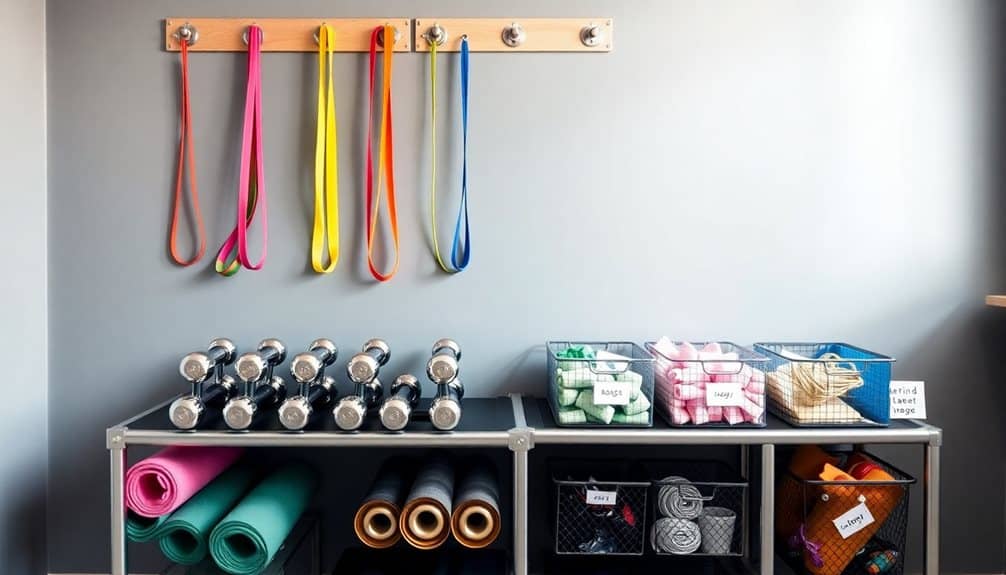
Building on your organized zones, implement clear labeling systems to maintain long-term order and accessibility. Create durable, easy-to-read labels for storage bins, shelves, and equipment racks using a label maker or waterproof markers. Include specific details like weight sizes, equipment categories, or frequency of use to streamline your workout process.
Establish a maintenance schedule to keep your organizational system running smoothly. Check labels monthly for wear and tear, replacing any that have become illegible or damaged. Clean equipment after each use and perform thorough sanitization weekly. Document your cleaning routine with a checklist to track completion and maintain accountability.
Set up a rotation system for frequently used items to prevent wear patterns and extend equipment life. Place return markers or outlines on storage surfaces so you’ll know exactly where each piece belongs. When you add new equipment, immediately create corresponding labels and designated spots within your zones. Consider taking photos of your organized setup to serve as a reference for proper placement and help maintain your system’s efficiency over time.
Frequently Asked Questions
How Often Should I Clean and Sanitize My Workout Equipment?
Just like your trusty chariot needs maintenance, your workout equipment requires regular cleaning. You should wipe down equipment after every use with a disinfectant spray or wipe. Do a deep cleaning weekly, focusing on handles, grips, and high-touch areas. If you’re sharing equipment, sanitize before and after each user. For rubber or foam materials, clean bi-weekly to prevent degradation and extend equipment life.
What’s the Best Way to Protect Equipment From Humidity Damage?
Store your equipment in a climate-controlled space and keep humidity levels below 50% using a dehumidifier. Install proper ventilation systems or fans to maintain air circulation. Apply protective coatings or rust inhibitors to metal surfaces, and use silica gel packets near vulnerable equipment. Wipe down gear after each use to remove moisture, and don’t store equipment directly on concrete floors. Consider moisture-resistant storage containers for smaller items.
Should I Keep Manuals and Warranty Information for My Fitness Equipment?
You’d need a million filing cabinets to store all your workout equipment paperwork, but keeping manuals and warranty info is absolutely essential. Store digital copies on your computer and cloud storage for backup. Keep physical documents in a waterproof folder, organized by equipment type. Label each document with purchase date and serial numbers, and staple receipts to warranty cards. Don’t forget to note warranty expiration dates in your calendar.
How Can I Prevent Rubber Mats From Leaving Marks on the Floor?
To prevent rubber mats from marking your floor, place a protective barrier underneath them, such as vinyl sheets or specialized mat underlayment. You’ll want to clean both the floor and mat’s underside regularly to remove dirt that can cause staining. If you’re using dark rubber mats, consider switching to lighter-colored alternatives. Don’t drag the mats when moving them, and make certain they’re completely dry before placing them on your floor.
What Temperature Range Is Ideal for Storing Workout Equipment?
Store your workout equipment in an environment between 60-75°F (15-24°C) to prevent damage. You’ll want to maintain humidity levels between 35-50% to avoid rust and mildew. Keep your gear away from direct sunlight and extreme temperature fluctuations. If you’re storing equipment in a garage or basement, use dehumidifiers in summer and heaters in winter to maintain ideal conditions.


